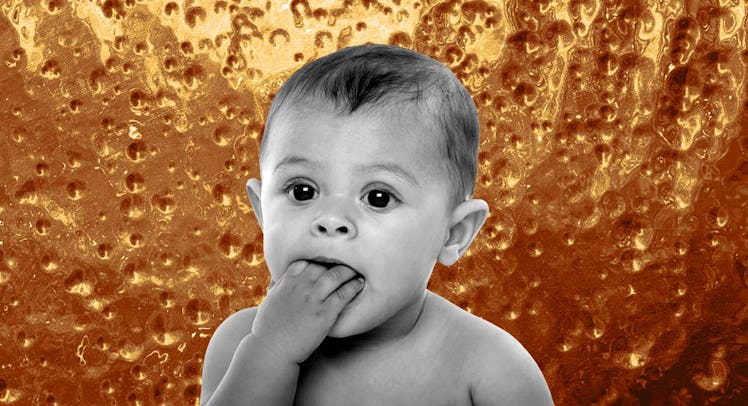Why Babies and Toddlers Will Eat Anything, But Prefer Coins and Metal
Coins are the most common thing babies put in their mouths, and there's a very specific reason for this.

Babies love change more than Barack Obama voters in 2008. Coins accounted for 61.7 percent of objects in children’s swallowing accidents and 79.7 percent of hospitalizations between 1995 and 2015. While there are many reasons kids put quarters in their mouths, one is particularly surprising: Children, like barracudas and magpies are naturally drawn to shiny things. Doctors believe young kids’ innate tendency to eat poop and dirt and put exciting objects in their mouths helps drive exposure to germs and bacteria, building better immune systems while slightly denting the family savings.
“There are a lot of behaviors that are innate and behaviors that are learned, and oral sampling is definitely an innate behavior,” explains otolaryngologist Dr. Micah Berman. If it wasn’t an innate behavior, only children in certain societies would do this, but it is a universal trait. “As soon as they have the motor control and head control to bring things into their mouths, they will.”
Babies are programmed to be orally fixated from birth because they learn from nursing that putting something in their mouths brings comfort. This works out pretty well for their immune systems, as early exposure to germs and bacteria in moderation helps children produce antibodies to fight off future infections and strengthen their underdeveloped immune systems. Known as the “hygiene hypothesis,” a theory receiving increasing support from researchers suggests that children who are not exposed to germs are at increased risk of developing allergies and illnesses. Getting germs through the mouth is, for fairly obvious reasons, better than getting germs through the bloodstream. That’s where oral sampling comes in.
“The mouth is full of immune organs, like your tonsils and adenoids, so the vast majority of what kids put in their mouth doesn’t cause infection,” Berman says.
But why coins? Children are drawn to change because it’s shiny, visually stimulating, and widely available. This can be situational exacerbated by children’s health. Children with autism spectrum disorder and other developmental disabilities are more likely to eat coins and, in rare instances, children might be drawn to the actual flavor of metal due a condition known as Pica, which stems from nutritional imbalances.
“Sometimes you need to do testing to see if there are any nutrient imbalances and check electrolytes and magnesium levels,” says pediatric occupational therapist Rachel Rudman, adding that a little listerine on a cotton swab can block these metallic cravings.
Rudman and Berman agree that in most cases, kids eat coins because it’s developmentally appropriate for them to put everything in their mouths. Even for young children, who should arguably know better, coin consumption makes sense because oral stimulation can soothe teething and dental issues. And there’s a major upsides to coins being so popular among babies and toddlers. Because they’re round, more often than not, kids can pass them safely through their digestive tracts. They also show up on x-rays, which can be a real relief for confused parents.
Still, eating anything inedible presents a danger. If the coins are caught in the airway or the child seems in distress, they will remove the coins, so it’s important to go to the ER and get checked out. During this procedure, children are put under anesthesia for 10 to 15 minutes while cameras are put through their esophagus or airway to retrieve the spare change. Even in those extreme instances, most children are perfectly fine.
“Some parents want the procedure, some want to avoid putting their babies under anesthesia,” says Berman. “But if it’s in the airway, or it could go in their airway or if they can’t swallow, doctors will want to operate to get it out.”